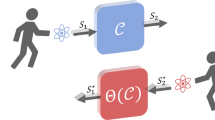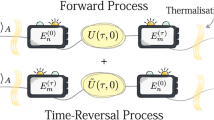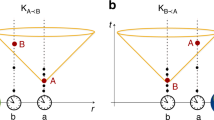Abstract
The symmetry of quantum theory under time reversal has long been a subject of controversy because the transition probabilities given by Born’s rule do not apply backward in time. Here, we resolve this problem within a rigorous operational probabilistic framework. We argue that reconciling time reversal with the probabilistic rules of the theory requires a notion of operation that permits realizations through both pre- and post-selection. We develop the generalized formulation of quantum theory that stems from this approach and give a precise definition of time-reversal symmetry, emphasizing a previously overlooked distinction between states and effects. We prove an analogue of Wigner’s theorem, which characterizes all allowed symmetry transformations in this operationally time-symmetric quantum theory. Remarkably, we find larger classes of symmetry transformations than previously assumed, suggesting a possible direction in the search for extensions of known physics.
This is a preview of subscription content, access via your institution
Access options
Subscribe to this journal
Receive 12 print issues and online access
$209.00 per year
only $17.42 per issue
Buy this article
- Purchase on Springer Link
- Instant access to full article PDF
Prices may be subject to local taxes which are calculated during checkout





Similar content being viewed by others
References
Wigner, E. P. Group Theory and Its Application to the Quantum Mechanics of Atomic Spectra (Academic Press, 1959).
Wigner, E. P. On unitary representations of the inhomogeneous Lorentz group. Ann. Math. 40, 149–204 (1939).
Schwinger, J. The theory of quantized fields I. Phys. Rev. 82, 914–927 (1951).
Lüders, G. On the equivalence of invariance under time reversal and under particle-antiparticle conjugation for relativistic field theories. Mat.-Fys. Medd. K. Dan. Vidensk. Selsk. 28, 1–17 (1954).
Pauli, W. in Niels Bohr and the Development of Physics (eds Pauli, W., Rosenfeld, L. & Weisskopf, V.) 30–51 (McGraw-Hill, 1955).
Bell, J. S. Time reversal in field theory. Proc. R. Soc. Lond. A 231, 479–495 (1955).
Watanabe, S. Symmetry of physical laws. Part 3. Prediction and retrodiction. Rev. Mod. Phys. 27, 179–186 (1955).
Aharonov, Y., Bergmann, P. G. & Lebowitz, J. L. Time asymmetry in quantum process of measurement. Phys. Rev. B 134, 1410–1416 (1964).
Holster, A. T. The criterion for time symmetry of probabilistic theories and the reversibility of quantum mechanics. New J. Phys. 5, 130 (2003).
Busch, P., Gabrowski, M. & Lahti, P. J. Operational Quantum Physics (Springer, 1995).
Ludwig, G. Foundations of Quantum Mechanics Vol. 1 (Springer, 1983).
Hardy, L. Quantum theory from five reasonable axioms. Preprint at http://arXiv.org/abs/quant-ph/0101012 (2001).
Barrett, J. Information processing in generalized probabilistic theories. Phys. Rev. A 75, 032304 (2007).
Hardy, L. Operational Structures as a Foundation for Probabilistic Theories (2009); http://pirsa.org/09060015.
Chiribella, G., D’Ariano, G. M. & Perinotti, P. Probabilistic theories with purification. Phys. Rev. A 81, 062348 (2010).
Dakic, B. & Brukner, Č. in Deep Beauty: Understanding the Quantum World Through Mathematical Innovation (ed. Halvorson, H.) (Cambridge Univ. Press, 2011).
Masanes, L. & Müller, M. P. A derivation of quantum theory from physical requirements. New J. Phys. 13, 063001 (2011).
Chiribella, G., D’Ariano, G. M. & Perinotti, P. Informational derivation of quantum theory. Phys. Rev. A 84, 012311 (2011).
Hardy, L. Reformulating and reconstructing quantum theory. Preprint at http://arXiv.org/abs/1104.2066 (2011).
Masanes, L., Mueller, M. P., Augusiak, R. & Perez-Garcia, D. Existence of an information unit as a postulate of quantum theory. Proc. Natl Acad. Sci. USA 110, 16373–16377 (2013).
Coecke, B. Quantum picturialism. Contemp. Phys. 51, 59–83 (2010).
Gammelmark, S., Julsgaard, B. & Mølmer, K. Past quantum states of a monitored system. Phys. Rev. Lett. 111, 160401 (2013).
Hawking, S. W. Arrow of time in cosmology. Phys. Rev. D 32, 2489–2495 (1985).
Mlodinow, L. & Brun, T. A. Relation between the psychological and thermodynamic arrows of time. Phys. Rev. E 89, 052102 (2014).
Aharonov, Y. & Rohrlich, D. Quantum Paradoxes: Quantum Theory for the Perplexed (Wiley, 2005).
Griffiths, R. B. Consistent histories and the interpretation of quantum mechanics. J. Stat. Phys. 36, 219–272 (1984).
Gell-Mann, M. & Hartle, J. B. in Physical Origins of Time Asymmetry (eds Halliwell, J. J., Perez-Mercader, J. & Zurek, W. H.) 311–345 (Cambridge Univ. Press, 1994).
Hartle, J. B. Unitarity and causality in generalized quantum mechanics for non-chronal spacetimes. Phys. Rev. D 49, 6543–6555 (1994).
Horowitz, G. T. & Maldacena, J. The black hole final state. J. High Energy Phys. 02, 008 (2004).
Gottesmann, D. & Preskill, J. Comment on “The black hole final state”. J. High Energy Phys. 2004, 026 (2004).
Bennett, C. H. Simulated Time Travel, Teleportation Without Communication, and How to Conduct a Romance with Someone who has Fallen into a Black Hole (QUPON, 2005); http://web.archive.org/web/20070206131550/http://www.research.ibm.com/people/b/bennetc/QUPONBshort.pdf.
Svetlichny, G. Effective quantum time travel. Preprint at http://arXiv.org/abs/0902.4898 (2009).
Lloyd, S. et al. Closed timelike curves via post-selection: Theory and experimental demonstration. Phys. Rev. Lett. 106, 040403 (2011).
Hardy, L. Probability theories with dynamic causal structure: A new framework for quantum gravity. Preprint at http://arXiv.org/abs/gr-qc/0509120 (2005).
Chiribella, G., D’Ariano, G. M., Perinotti, P. & Valiron, B. Quantum computations without definite causal structures. Phys. Rev. A 88, 022318 (2013).
Oreshkov, O., Costa, F. & Brukner, Č. Quantum correlations with no causal order. Nature Commun. 3, 1092 (2012).
Oreshkov, O. & Cerf, N. J. Operational quantum theory without predefined time. Preprint at http://arXiv.org/abs/1406.3829 (2014).
Leifer, M. S. & Spekkens, R. W. Towards a formulation of quantum theory as a causally neutral theory of bayesian inference. Phys. Rev. A 88, 052130 (2013).
Arrighi, P., Nesme, V. & Werner, R. Unitarity plus causality implies localizability. J. Comput. Syst. Sci. 77, 372–378 (2011).
Colbeck, R. & Renner, R. No extension of quantum theory can have improved predictive power. Nature Commun. 2, 411 (2011).
Coecke, B. & Lal, R. Time-asymmetry of probabilities versus relativistic causal structure: An arrow of time. Phys. Rev. Lett. 108, 200403 (2012).
Wood, C. J. & Spekkens, R. W. The lesson of causal discovery algorithms for quantum correlations: Causal explanations of Bell-inequality violations require fine-tuning. New J. Phys. 17, 033002 (2015).
Fritz, T. Beyond Bell’s theorem II: Scenarios with arbitrary causal structure. Preprint at http://arXiv.org/abs/1404.4812 (2014).
Bancal, J.-D. et al. Quantum nonlocality based on finite-speed causal influences leads to superluminal signaling. Nature Phys. 8, 867–870 (2012).
Rudolph, T. Quantum causality: Information insights. Nature Phys. 8, 860–861 (2012).
Baumeler, Ä., Feix, A. & Wolf, S. Maximal incompatibility of locally classical behavior and global causal order in multiparty scenarios. Phys. Rev. A 90, 042106 (2014).
Brukner, Č. Quantum causality. Nature Phys. 10, 259–263 (2014).
Coecke, B. Terminality implies non-signalling. Electron. Proc. Theor. Comput. Sci. 172, 27–35 (2014).
Pienaar, J. & Brukner, Č. A graph-separation theorem for quantum causal models. Preprint at http://arXiv.org/abs/1406.0430 (2014).
Ried, K. et al. A quantum advantage for inferring causal structure. Nature Phys. 11, 411–420 (2015).
Davies, E. & Lewis, J. An operational approach to quantum probability. Commun. Math. Phys. 17, 239–260 (1970).
Kraus, K. States, Effects and Operations (Springer, 1983).
Aharonov, Y. & Vaidman, L. The two-state vector formalism: An updated review. Lect. Notes Phys. 734, 399–447 (2008).
Barnett, S. M., Pegg, D. T. & Jeffers, J. Bayes’ theorem and quantum retrodiction. J. Mod. Opt. 47, 1779–1789 (2000).
Wolf, M. M. Quantum channels & operations: Guided tour. Preprint at http://www-m5.ma.tum.de/foswiki/pub/M5/Allgemeines/MichaelWolf/QChannelLecture.pdf (2012).
Wick, G. C., Wightman, A. S. & Wigner, E. P. The intrinsic parity of elementary particles. Phys. Rev. 88, 101–105 (1952).
Acknowledgements
This work was supported by the European Commission under the Marie Curie Intra-European Fellowship Programme (PIEF-GA-2010-273119) and by the F.R.S.–FNRS under the Chargé de recherches (CR) Fellowship Programme.
Author information
Authors and Affiliations
Contributions
O.O. conceived the project, developed the concepts and wrote the manuscript. N.J.C. supervised the project, discussed the results and edited the manuscript.
Corresponding author
Ethics declarations
Competing interests
The authors declare no competing financial interests.
Supplementary information
Supplementary Information
Supplementary Information (PDF 237 kb)
Rights and permissions
About this article
Cite this article
Oreshkov, O., Cerf, N. Operational formulation of time reversal in quantum theory. Nature Phys 11, 853–858 (2015). https://doi.org/10.1038/nphys3414
Received:
Accepted:
Published:
Issue Date:
DOI: https://doi.org/10.1038/nphys3414
This article is cited by
-
Quantum operations with indefinite time direction
Communications Physics (2022)
-
Time-reversal of an unknown quantum state
Communications Physics (2020)
-
Markovian and Non-Markovian Quantum Measurements
Foundations of Physics (2020)
-
In Search of Time Lost: Asymmetry of Time and Irreversibility in Natural Processes
Foundations of Science (2020)
-
Arrow of time and its reversal on the IBM quantum computer
Scientific Reports (2019)



